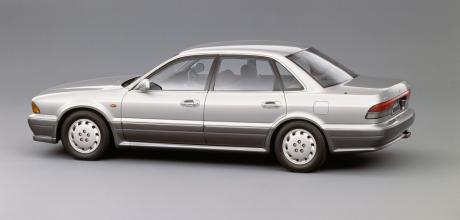1995 Mitsubishi Diamante - first car with adaptive cruise control
Eagle-eyed readers may remember the innocuous-looking Diamante from our May 2020 Innovators piece on the first production car to feature cruise control: the 1958 Chrysler Imperial. While it may have been relegated to footnote status in that particular article, the Diamante is an innovator thanks to its special place in automotive history as the first production car to offer a form of adaptive cruise control.
THE INNOVATORS
The cars we drive today were influenced by these pioneers
The beating heart of this innovation is Diamante’s lidar system. Essentially, lidar is a way of determining distance by targeting an object with a laser and measuring the time it takes the reflected light to get back to the receiver. Using a sweeping scanning pattern, lidar can also be used to map landscapes and structures quickly and accurately. This has resulted in its application across a number of disciplines, including geosciences and military surveillance, before it eventually found its way into the automotive sphere.
In Mitsubishi’s case, lidar was first used on the marque’s 1992 Debonair sedan to scan for objects and other vehicles on the road. This early system served to warn the driver of potential hazards and didn’t influence braking, transmission or any other system in the car. Just a couple of years later, Mitsubishi offered an uprated version of the lidar-assisted safety system dubbed Preview Distance Control. This unit comprised a lidar sensor in the front bumper and a camera mounted in the housing of the rear-view mirror. When the lidar detected a vehicle closing in ahead, it would send a signal to the car’s ECU to reduce the throttle or cause the gearbox to gear down to slow the car and maintain a set distance between it and the vehicle in front. As the system didn’t have any control over the car’s brakes, it was limited to an operating speed of 108 km/h and supplemented the accelerator and gearing reductions with audible and visual warnings for the driver to intervene.
A system offering automated braking intervention would emerge only in 1998 as part of the early Distronic system fitted to the W220-generation Mercedes-Benz S-Class.
In addition to its prohibitive initial cost, lidar faces several obstacles in its adoption as the hazard-detection medium of choice for automobiles. While it is highly accurate and can operate in high- and low-light conditions, lidar is adversely affected by rain and fog; the water droplets can refract the laser and distort measurement readings. Consequently, many of the modern active safety systems utilising lidar today complement it with radar and stereoscopic camera feeds, each capable of compensating for conditions that can potentially affect the other.
THEY ALSO PAVED THE WAY
1952 OLDSMOBILE 88
In 1952, several General Motors-models, including the 88, came fitted with the Autronic Eye; a photosensor linked to a two-step relay that would dim the car’s headlamps whenever an oncoming vehicle was detected.
1967 CITROEN DS
The svelte Citroen DS was the first production car to feature adaptive headlamps linked right to the steering mechanism, allowing the headlights to track into corners at an angle of up to 80 degrees from straight ahead.
2003 HONDA INSPIRE
The Inspire was one of the first production-series cars to feature a collision-mitigation braking system(CMBS). The system used a radar feed to detect pedestrians and other obstacles and automatically apply emergency braking if required.
2005 VOLVO S80
Volvo is famed for its safety innovations. The 2005 launch of the S80 ushered in a very useful one in the guise of a blind spot information system (BLIS), which uses a radar and camera feed to inform drivers of any vehicles hiding in their blind spot.


